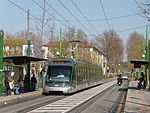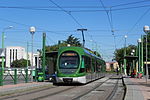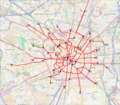Milan tram
| Milan tram | |
|---|---|
| Ventotto car on line 1 in Piazza Cavour | |
| Basic information | |
| Country | Italy |
| city | Milan |
| opening | 1881 |
| operator | Azienda Trasporti Milanesi (ATM) |
| Infrastructure | |
| Route length | 116.6 km |
| Gauge | 1445 mm |
| Smallest radius | 15 m |
| Power system | 600 volts = overhead line |
| Depots | 5 |
| business | |
| Lines | 18th |
The Milan tram is one of the most traditional means of local transport in Italy with what was once a very extensive route network. The tram network in the Lombard capital Milan now consists of 18 lines, 17 of which are inner-city lines. It has a total length of almost 116.6 kilometers.
network
(As of September 8, 2018)
| line | Line route | Vehicle use |
|---|---|---|
| 1 | Greco (Via Martiri Oscuri) ↔ Roserio | Ventotto (1501-2002) |
| 2 | Piazza Bausan ↔ Piazzale Negrelli | 4601-4613, 4714-4733 |
| 3 | Duomo (Via Cantù) ↔ Gratosoglio | Jumbotram (4900-4999) |
| 4th | Piazza Castello ↔ Niguarda (Parco Nord) ( Metrotranvia Nord ) | Sirio (7101-7148) |
| 5 | Ortica (Via Milesi) ↔ Ospedale Niguarda | Ventotto (1501-2002) |
| 7th | Piazzale Lagosta ↔ Precotto (Via Anassagora) ( Metrotranvia di Bicocca ) | Sirietto (7501-7535,
7601-7633) |
| 9 | Stazione Centrale (Piazza IV Novembre) ↔ Stazione Genova | Sirietto (7501-7535,
7601-7633) |
| 10 | Viale Lunigiana ↔ Piazza XXIV Maggio | Ventotto (1501-2002) |
| 12 | Roserio ↔ Viale Molise | Jumbotram (4900-4999) |
| 14th | Cimitero Maggiore ↔ Lorenteggio | Sirietto (7501-7535,
7601-7633) |
| 15th | Duomo ↔ Rozzano (Via Guido Rossa) ( Metrotranvia Sud ) | Eurotram (7001-7026) |
| 16 | San Siro Stadium (Piazzale Axum) ↔ Via Monte Velino | Jumbotram (4900-4999) |
| 19th | Stazione Lambrate ↔ Piazza Castelli | Ventotto (1501-2002) |
| 24 | Piazza Fontana ↔ Vigentino (Via Selvanesco) | Sirietto (7501-7535,
7601-7633) |
| 27 | Piazza Fontana ↔ Viale Ungheria | Jumbotram (4900-4999) |
| 31 | Bicocca ↔ Cinisello (Via I Maggio) ( Metrotranvia di Cinisello ) | Sirio (7101-7148) |
| 33 | Piazzale Lagosta ↔ Lambrate | Ventotto (1501-2002) |
| 179 | Milan (Comasina) ↔ Limbiate | ATM 500 |
history
After many years of discussion, the first horse-drawn trams were opened in 1881 and operated by the Società Anonima degli Omnibus (SAO).
The first electric tram was opened on November 1, 1893 by Edison as a test route. Thanks to its great success, the SAO was incorporated into Edison and its lines were gradually electrified.
In 1917, the tram operation was taken over directly by the city administration, which founded the Ufficio Tramviario Municipale (Municipal Tramway Office).
The railways, which were operated in left-hand traffic , were converted to right -hand traffic in 1926 . The large tram network was also the reason why Milan was the last city in Italy to switch the roads to right-hand traffic, while in the province of Milan people used to drive on the right. Extensive modifications and adaptations were necessary. The changeover took place on August 3, 1926. In the evening all trams drove to the depot, only to leave after midnight, this time on the right. During the whole night it was checked that everything was working properly. In the Corriere della Sera there are five articles on this major event.
In 1928, the first production cars of the famous 1500 series went into operation, which still shape the cityscape today.
In 1931 the UTM was transformed into an independent company called Azienda Tranviaria Municipale (ATM).
The network suffered severe damage in the Second World War , but was fully operational again by the end of 1945. The railway, which was somewhat neglected in the post-war years , felt the competition from the newly built Milan underground from November 1, 1964 . In the meantime, 17 of the 40 lines remained after the end of the war, there are no longer any dashed line signals or red line numbers .
Since October 2006, ATMosfera has offered the opportunity to dine in a restored and converted tram.
Car 1544 with roller pantograph , 1967
Network development
The scale changes as a result of route extensions on the periphery from map to map.
Planning
Further new lines are planned for the coming years:
- Line 27 is to be extended from Viale Ungheria through the new Santa Giulia district to Rogoredo station.
- Line 24 is to be extended from Vigentino beyond the city limits via Noverasco and Opera to Locate di Triulzi.
- In the medium term, the overland tram to Limbiate and the former line to Desio are to be converted into modern express trams (with some double-track expansion).
- In the long term, the Bicocca line (7) is to run as Metrotranvia interperiferica Nord between Piazzale Bausan via the Certosa S-Bahn station to the Cascina Gobba underground station .
- One or more lines are being planned between Cascina Gobba, Sesto San Giovanni and Monza .
The interurban trams
In addition to the inner-city tram network, the overland network around Milan also grew. The first horse-powered intercity tram was opened between Milan and Monza in 1876 by the Società Anonima degli Omnibus .
The first steam tram came between Milan and Vaprio d'Adda in 1878 and was operated by the Società Anonima del Tramway Milano-Gorgonzola-Vaprio . The numerous companies later merged to form Tranvie Interprovinciali Padane , one of the largest tram operators in Europe.
In 1919 Edison , which had operated the city's tram network until 1917, founded the Società Trazione Elettrica Lombarda (STEL). STEL took over the most frequented routes from TIP and electrified them, while the others were converted to bus services . The network of the STEL was taken over on July 1, 1939 by the municipal Azienda Tranviaria Municipale .
After the Second World War, the network was steadily reduced in size. With the exception of one route to Limbiate , operations have now been discontinued on all overland lines. The routes to the east and north have been taken over by underground line 2. The lines to Monza have also been completely discontinued .
Company workshops
There are currently five depots :
- Deposito Baggio
- Deposito Leoncavallo
- Deposito Messina
- Deposito Precotto
- Deposito Ticinese
vehicles
| Numbers | designation | Years of construction | Manufacturer | length | width | v / max | Seats | Standing room | number | |
|---|---|---|---|---|---|---|---|---|---|---|
 |
1501-2002 | Ventotto | 1927-1930 | various | 13.89 m | 2.35 m | 42 km / h | 29 | 101 | 502, 151 still in operation |
 |
4601-4613 | 1955 | OMS, TIBB , Breda | 19.58 m | 2.4 m | 45 km / h | 36 | 140 | 13, 10 still in operation |
|
 |
4714-4733 | 1956-1960 | OMS, TIBB, Breda | 19.58 m | 2.4 m | 45 km / h | 36 | 140 | 20th | |
 |
4900-4999 | Jumbotram | 1976-1988 | GAI | 29.01 m | 2.38 m | 60 km / h | 59 | 207 | 100 |
 |
7001-7026 | Eurotram | 1999-2000 | Adtrance | 34.10 m | 2.47 m | 70 km / h | 68 | 194 | 26th |
 |
7101-7148 | Sirio | 2002-2009 | AnsaldoBreda | 35.35 m | 2.4 m | 70 km / h | 71 | 214 | 48 |
 |
7501-7535 | Sirietto | 2003-2009 | AnsaldoBreda | 25.15 m | 2.4 m | 70 km / h | 50 | 141 | 35 |
 |
7601-7633 | Sirietto | 2008-2009 | AnsaldoBreda | 25.15 m | 2.4 m | 70 km / h | 50 | 141 | 33 |
Eleven Peter Witt-type vehicles that were no longer required were sold to San Francisco in 1998 , where they are in service on the F-Market & Wharves line. Others were bought by the US company Gomaco Trolley Company in around 2005 . This restores the vehicles and sells them to US tram companies as historic tram cars.
Former vehicle types
| Numbers | designation | Years of construction | Manufacturer | length | width | v / max | Seats | Standing room | number |
|---|---|---|---|---|---|---|---|---|---|
| ATM 85-92 | 1928 | Reggiane | 13.56 m | 60 km / h | 36 | 50 | 8th | ||
| 4800-4844 | 1973-1977 | ATM Milano , Officine di Cittadella | 27.89 m | 2.4 m | 45 km / h | 49 | 231 | 45 |
Trivia
The Milan tram also appears in a Walt Disney comic. The comic was published in a total of 13 countries.
See also
literature
- Giovanni Cornolò. Fuori porta in tram. Le Tranvie extraurbane milanesi 1876–1980. Ermanno Albertelli Editore, Parma 1980.
- Giovanni Cornolò, Giuseppe Severi. Tram e tramvie a Milano 1840–1987. Azienda Trasporti Municipali, Milan 1987.
- Paolo Zanin: Primi tram a Milano. Nascita e sviluppo della rete tranviaria (1841-1916). Editrice Trasporti su Rotaie, Salò 2007, ISBN 978-88-85068-07-0 .
Web links
- Metrotranvie at MSR Milano
- Milan tram at Milano Trasporti
- Photo collection at Photorail
- Pictures of the Milan tram











